Three years have passed since the WHO declared the outbreak of the COVID-19 pandemic, and whilst in some parts of the world, the worst seems to be behind us, the pandemic’s impact has lingered on in our daily life, especially in the work world.
For example, many businesses tried out remote work for the first time during COVID-19. While some have since returned to the office full-time over the past year as we’ve entered the “new normal”, hybrid and flexible work continue to be popular in a post-pandemic world.
With the help of market research agency OnePoll, we conducted a survey of 1000 US office workers and knowledge workers from a range of levels and industries to bring you a few key insights on current work trends and the state of hybrid work.
Read on to learn more!
Key hybrid work statistics and hybrid work trends for 2023
- Today, 25% of US companies offer employees the opportunity to work from home half the time. This represents a significant jump from just 15% before the pandemic.
- Before the pandemic, 40% of US companies worked on-site full-time. That figure has dropped slightly to 31% today.
- 62% of companies have returned to the same working model they had pre-pandemic.
- 71% of US employees are happy with the working model being used in their current job.
The majority of companies returned to the same working model they had before, with only a few permanently transitioning
The pandemic caused a sea change in ways of working since many companies were forced to switch to a fully-remote model during lockdowns. This led to widespread technological investment and experimentation with new types of workplace communications.
At the time, many observers speculated on what the future of work would be, wondering whether this would lead to a permanent transition to remote work. Our research shows that for the most part, this didn’t happen. In fact, 62% of companies have returned to the same working model they had pre-pandemic.

However, some companies did decide to change the way they work for good—but most of these opted to go hybrid, not remote. Just 4% of companies shifted to a fully-remote model, while 16% of companies moved to a hybrid work model instead, choosing to go into the office for part of the time. These changes resulted to 5% of companies now being fully remote, and 25% having a hybrid model in place.
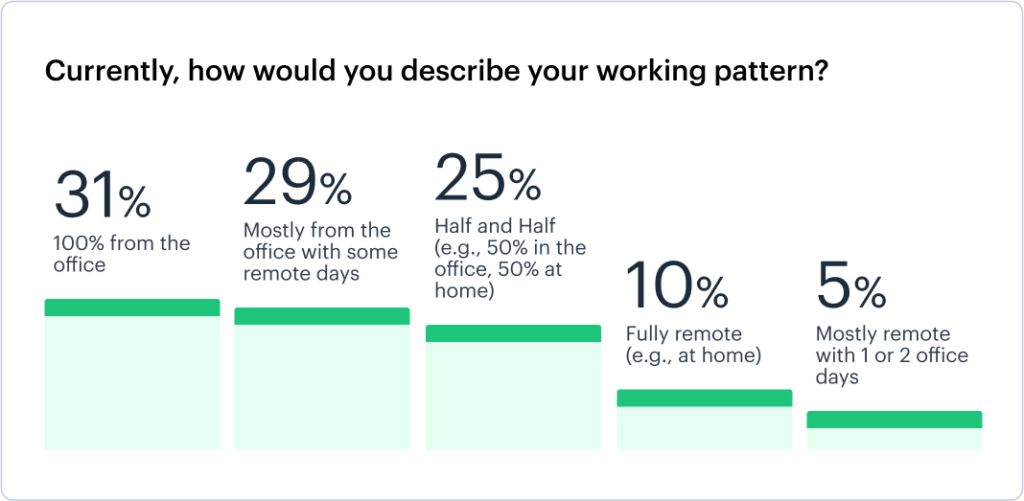
This shows that while the changes caused by the pandemic offered many new opportunities, for the most part, companies felt that something was lost in the transition to fully remote work.
Employees love the freedom and flexibility of hybrid work, but it’s not without its problems
Hybrid work may be perceived as a good compromise solution, since it offers some of the freedom and flexibility of remote, while maintaining the benefits of in-person communication in an office environment.
But does hybrid work really work for employees?
The employees we surveyed had a variety of opinions on the hybrid workplace schedule. While some enjoyed the freedom, others struggled with the isolation of working from home. Survey respondents said their favorite perks of hybrid work were:
- Less time spent commuting
- The balance between interacting with colleagues and spending time at home
- Positive effects on physical and mental wellbeing
- Better work-life balance

On the other hand, they felt that hybrid work’s main drawbacks were:
- A negative impact on mental health
- Not as much face-to-face interaction with colleagues
- A poor setup or bad equipment at home
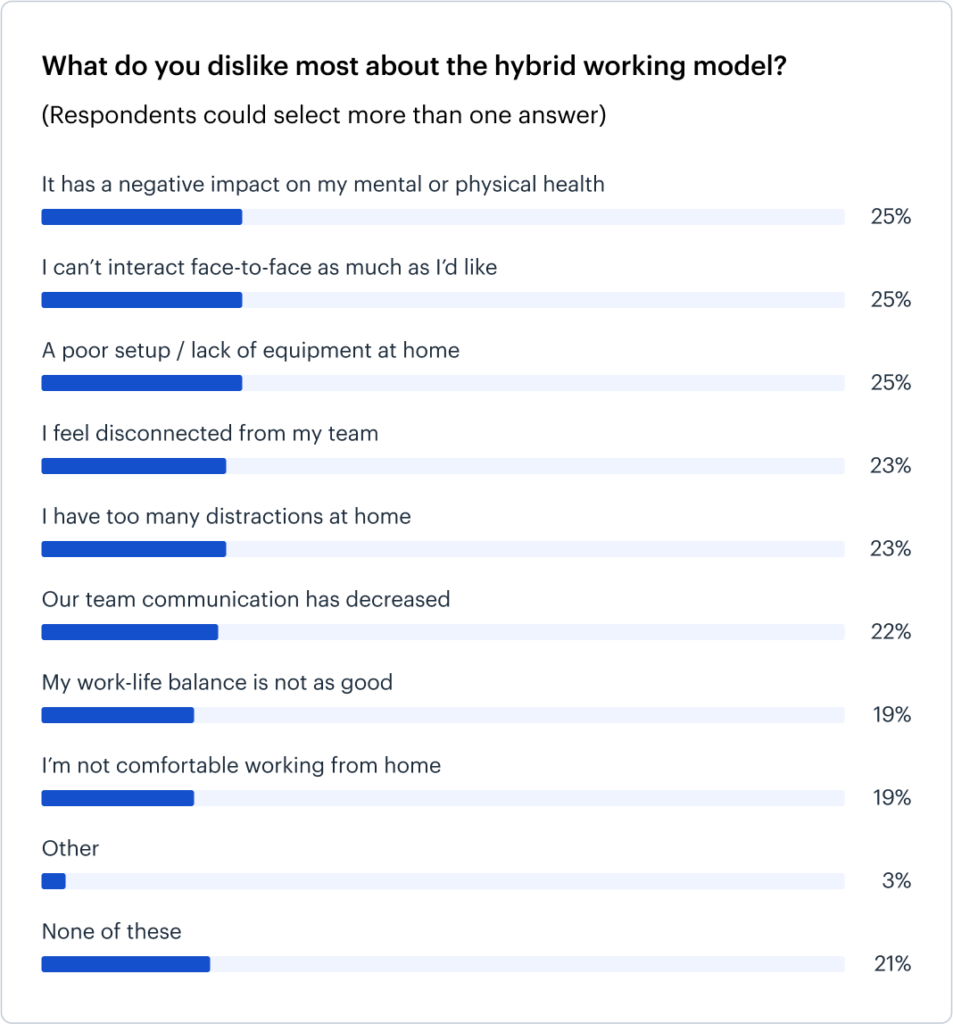
Interestingly, respondents referred to both “negative mental health” and “positive mental wellbeing”, two seemingly contradictory points.
Hybrid work can impact people very differently, depending on their individual personalities and preferences. While the flexible schedule and work-life balance provided by hybrid work can have a positive impact on mental health, it also comes with fewer interactions with colleagues and a less structured routine, which may lead to burnout or cause some employees to struggle.
Lack of access to a properly-equipped, private home office space can also be a problem for hybrid and remote employees—a comfortable and ergonomic workspace is crucial for mental and physical wellness.
Nearly a third of employees are required to go into the office at least three times a week—and people are happy about it!
There are many variations on a hybrid work schedule, with some companies leaning more towards remote and others leaning more towards in-person office work. While companies don’t always require their hybrid employees to spend a specific number of days in the office, the majority (58%) do.
Most of these organizations require more in-office days than remote days. Of survey respondents who said their employer required a certain amount of office attendance, 32% were required to go into the office at least three times a week, with an additional 20% being asked to go in four times a week.
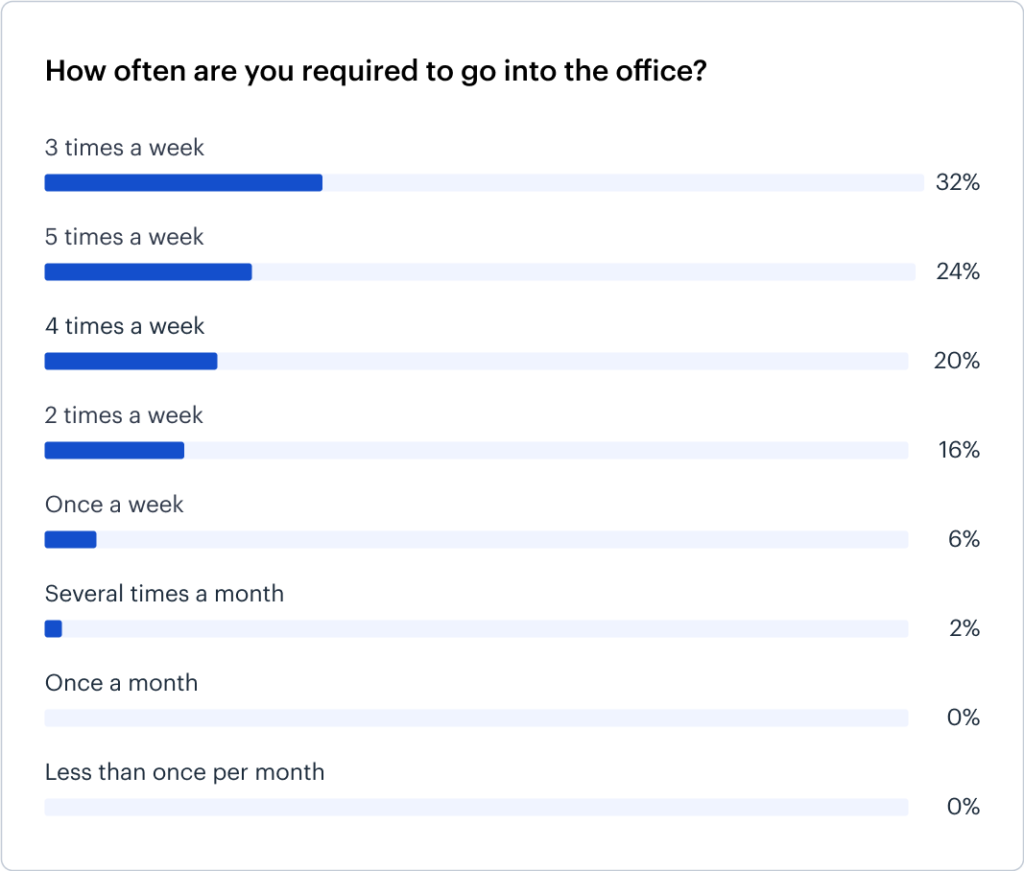
The vast majority of employees say they are more or less satisfied with the number of days they are required to go in. 48% say they wouldn’t change anything about their current work arrangement, while an additional 41% say they are generally happy, although they would prefer more flexibility.

Clearly, there’s no perfect way to do hybrid work and be successful—various schedules may work well for different companies. Regardless of the exact type of work schedule chosen, employees enjoy having that bit of extra flexibility in their week.
Nearly a third of employees have the flexibility to work from abroad for an unlimited number of days per year
Surprisingly, 33% of employees report that their company allows them to work remotely from abroad for an unlimited number of days per year, with an additional 23% saying they are allowed to work from abroad for a set amount of time.
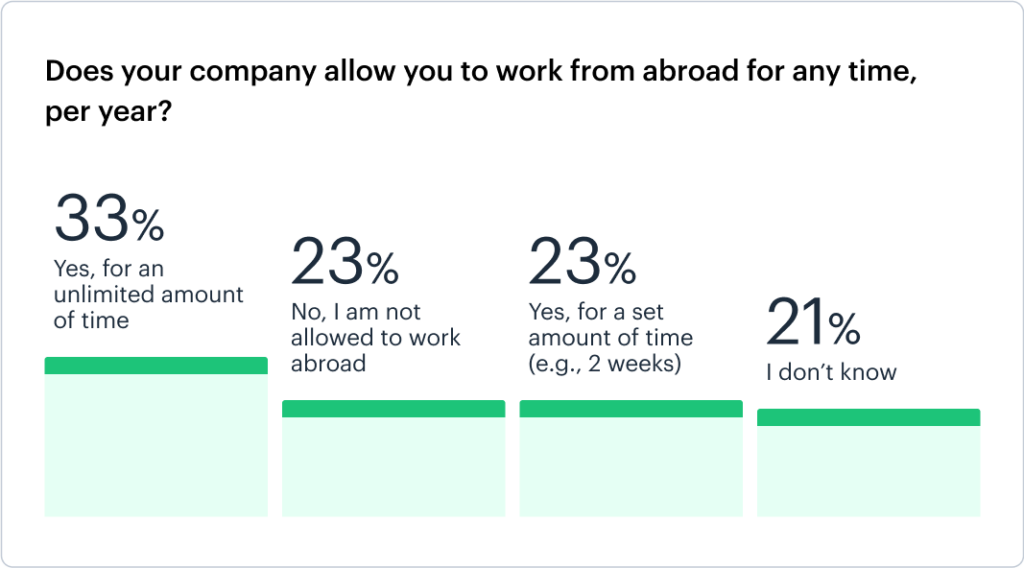
This is unexpected for a few reasons. First, most companies place a high priority on office attendance (as shown above). Second, working from abroad can open up a number of important tax, security, and legal implications (to learn more about these, check out our blog post on global mobility management.)
However, many companies are still open to the idea of employees working remotely from a different geographical location. Giving employees the freedom to work while traveling can be an attractive job perk, helping companies to build their employer brand and attract top talent. In addition, there can also be business benefits to letting employees choose a temporary work location abroad—it may lead to business development opportunities, or closer connections with overseas company offices.
Easily manage business travel
Seamlessly plan your next trip abroad with these 20 top-rated travel management tools
Meeting colleagues in person is an essential part of working life
There’s a reason why many employers require at least some office attendance, and why many employees enjoy going into the office—collaborating with other team members face to face has many benefits, and can be an important part of working life.
When asked for their top reasons why seeing their colleagues in person was important to them, survey respondents cited:
- Heightened productivity and creativity (51%)
- A sense of belonging within the team (49%)
- Improved company culture (46%)
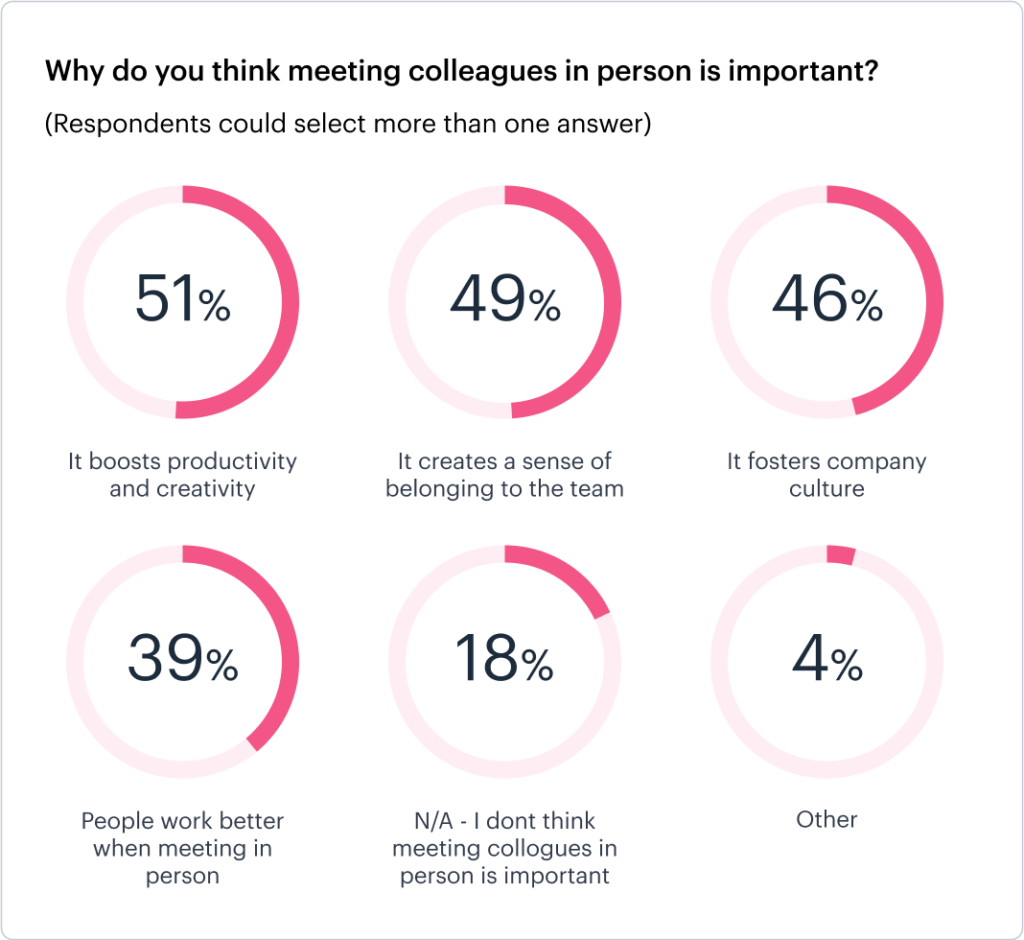
In-person collaboration can make it easier to work on complex projects. It can also improve mental well-being by encouraging more social interaction, and foster a sense of connectedness with the company’s mission.
Most respondents found that face to face meetings were helpful for creative and strategic activities. 34% listed brainstorming sessions as their top priority when going into the office. Others listed their most important office-based activities as:
- 1:1 meetings (33%)
- skills development workshops (33%)
- large-group meetings (31%)
On the social end of things, participants also valued spending time with new colleagues (29%) and participating in social activities (26%).
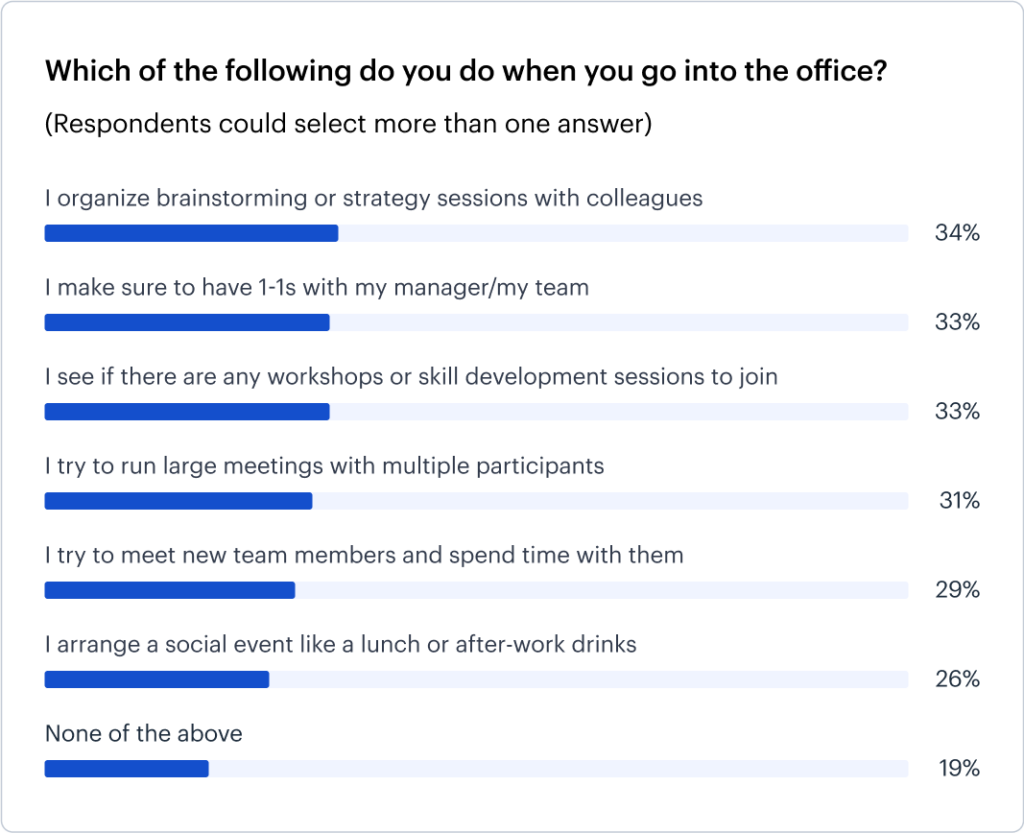
Over half of respondents working fully-remotely claim they never get together with their colleagues for social events
Clearly, many employees enjoy and benefit from in-person meetings. And of course, the office isn’t the only place employees can get together in person—many fully-remote companies also hold offsites and events for employees to meet up a few times per year. However, our data show that over half of remote companies don’t do this.
On the other hand, just 17% of respondents from hybrid companies said they never met with colleagues face to face for these types of events. Besides being in the office more often, hybrid workers also participate in team building activities more frequently than remote workers, with most meeting once a month (25%) or several times a month (23%) for team building.
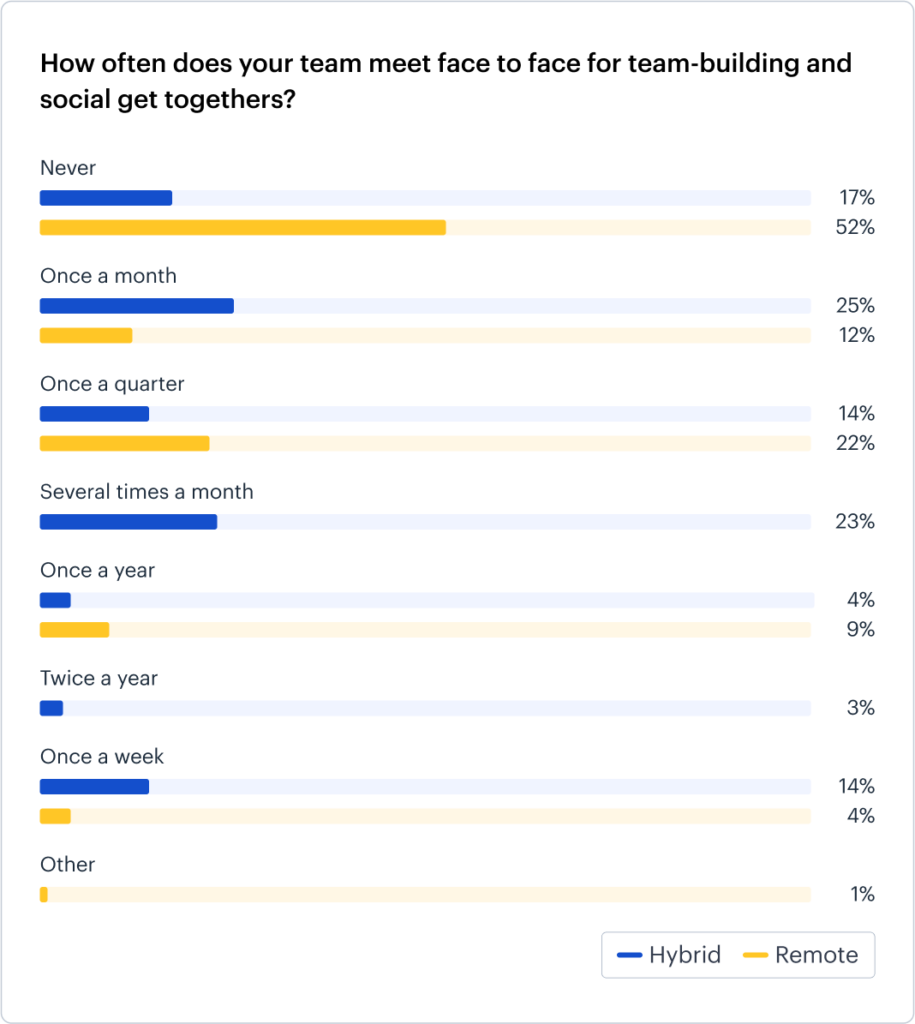
Team building has been shown to have an important impact on company culture and the employee experience, creating a positive work environment and driving business performance. In fact, up to 55% of employee engagement is driven by this type of non-financial recognition, according to McKinsey. And data from Gallup show that highly-engaged business units enjoy lower absenteeism and higher employee productivity.
Looking for ways to improve your company culture?
Events foster a positive work environment and boost morale. These best business travel services on the market can help you organize your next team event
Over 72% of businesses run company-wide events at least once a year, if not more
Overall, company events are quite a popular activity. The majority of organizations choose to organize these events at least once per year. 36% of businesses run company events once a year, while 28% do so 2-3 times per year, and an additional 8% run them 3+ times a year.
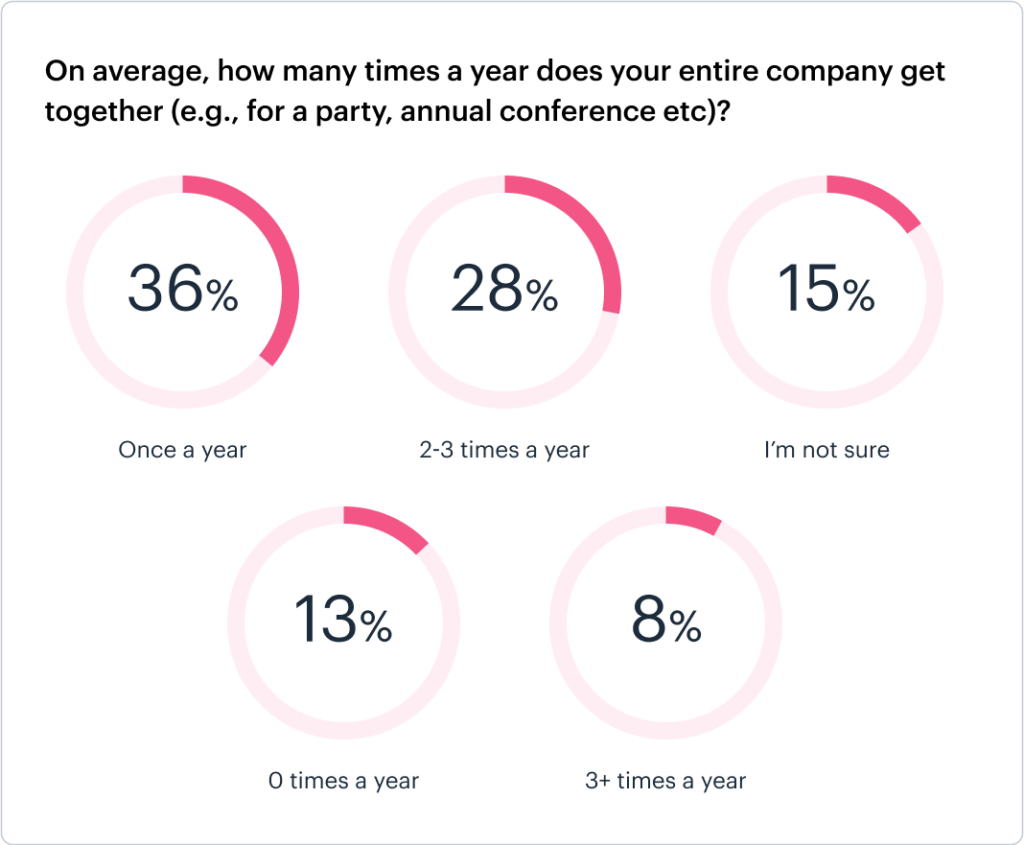
So what kinds of events are the most common? Unsurprisingly, most companies prioritize socializing and professional development during their in-person get-togethers. The most frequently-organized company events include:
- Seasonal parties, such as Christmas, holiday, or summer parties (41%)
- Employee recognition events, such as employee of the month/quarter (39%)
- In-office social events, such as Friday drinks (37%)
Other popular types of company events include:
- Team building sessions (33%)
- Conferences, exhibitions, and summits (33%)
- In-person offsites and retreats (27%)
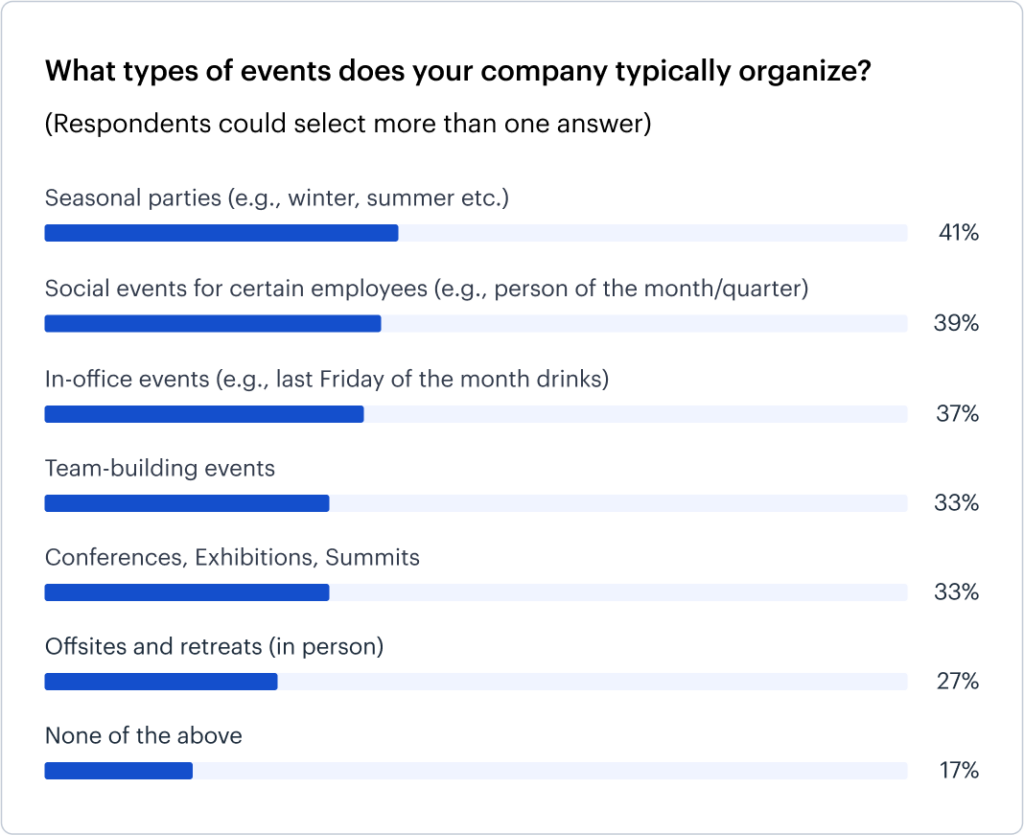
Organizing events can be challenging for remote and hybrid companies. These businesses often have employees based in different offices, or working remotely from various parts of the country or world.
To pull off a successful company event, coordinating group travel is essential—but managing bookings, agendas, and meetings for multiple travelers can get complicated pretty quickly. This process is made much simpler with the right travel management software.
Group travel made easy
Coordinating travel for your team is no problem with these 5 great group travel software options
If you only want to read the summary...
There’s a lot to take in here! Whether you’re a human resources manager, a people and culture decision maker, a team manager, or a C-suite business leader trying to decide how things will work at your company in the next year and beyond, here’s a quick overview of the key takeaways from our survey:
- Most companies have returned to the way they were working before the pandemic, with some switching permanently to hybrid, and a few going fully remote.
- Employees enjoy greater work-life balance with hybrid and remote work options, but still miss interacting with their colleagues face to face.
- Different types of hybrid workweek schedules can work for different companies, with most opting for three or four workdays in the office per week. In general, this setup meets employee expectations; most are satisfied with the way their employers are managing their company’s work culture.
- Over half of employees are allowed to work from abroad at least some of the time, and companies see value in this type of working arrangement.
- Meeting with colleagues in person for social and work-related reasons has many benefits, and most companies run company-wide events at least once a year. However, hybrid teams are more likely to meet for these types of events than remote teams.
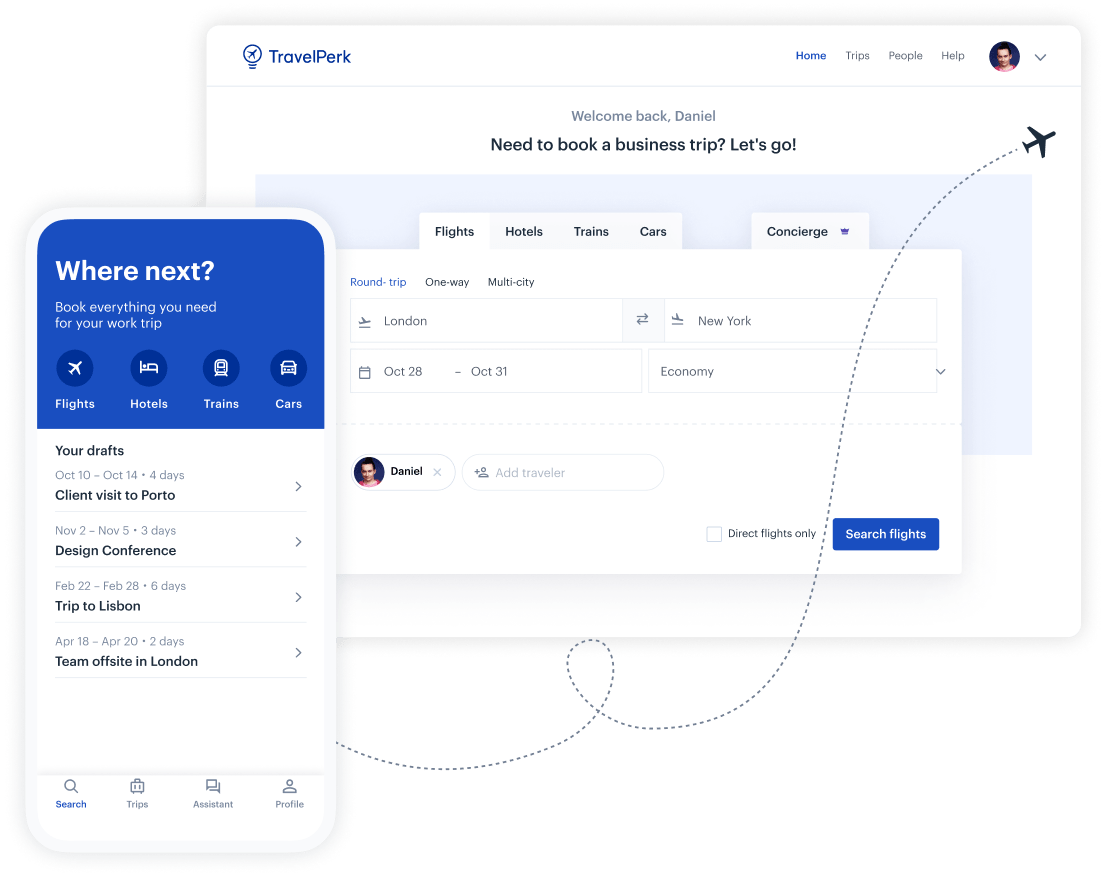
Make business travel simpler. Forever.
-
See our platform in action. Trusted by thousands of companies worldwide, TravelPerk makes business travel simpler to manage with more flexibility, full control of spending with easy reporting, and options to offset your carbon footprint.
-
Find hundreds of resources on all things business travel, from tips on traveling more sustainably, to advice on setting up a business travel policy, and managing your expenses. Our latest e-books and blog posts have you covered.
-
Never miss another update. Stay in touch with us on social for the latest product releases, upcoming events, and articles fresh off the press.



